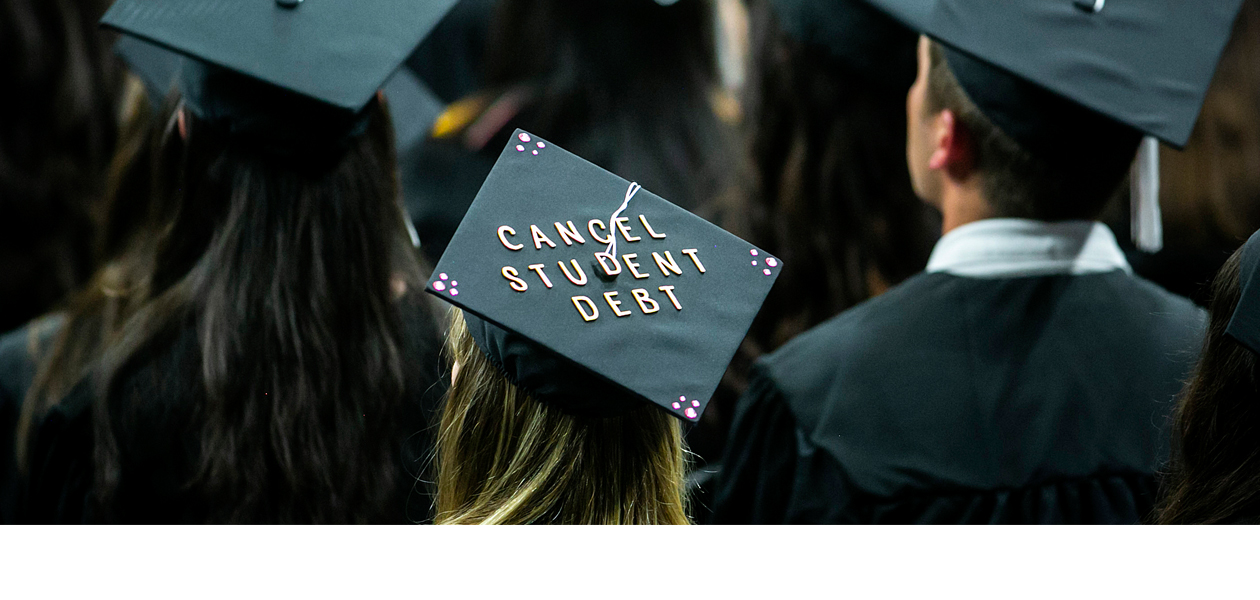
Over 43 million people will have some or all of their crippling student debt canceled, including 20 million entirely, under a historic executive order issued by Pres. Joe Biden. The student debt crisis has ballooned into a $1.75 trillion impossible burden for 45 million people and their families.
Activists who have organized for cancelation for years hailed the announcement but saw it as an essential first step. “Everyone, let’s take 5 minutes to dwell on this fact: 20 million beautiful human beings will have $0 of debt. We’ve moved mountains. Only a few more Himalayas left to go!” tweeted The Debt Collective.
The order cancels up to $20,000 in federal student loans for 27 million people receiving Pell Grants and up to $10,000 for another 16 million without Pell grants. Individuals making under $125,000 a year and couples making $250,000 will qualify.
Students from low-income families, of which 97% earn less than $60,000/year, are eligible for Pell grants. At one time, Pell grants covered 80% of the cost of education. Today it’s closer to 30%.
“The cost of education has gone up significantly,” said Biden, announcing the action on Aug. 24. “An entire generation has been saddled with an unsustainable debt in exchange for an attempt at a college degree.”
Biden said student debt borrowers were still feeling the effects of the economic crisis caused by the pandemic. “With this action, people can finally get on with their lives and get out from under a mountain of debt,” he said, asserting the whole economy would benefit.
The American Rescue Plan extended emergency relief to tens of millions and canceled PPP loans to small businesses totaling $700 billion. “Now is the time to address the student debt burden. No one complained [about actions taken during the pandemic], and any outrage over this is dead wrong,” Biden said.
Republican elected officials predictably opposed the debt cancellation, calling it a “giveaway,” and said taxpayers would foot the bill. They asserted, without any basis, that the cancelation would increase inflation but offered no solution to the crisis. Biden blasted the hypocrisy, saying Republicans had no hesitation in passing a $2 trillion tax cut for the wealthiest Americans and radically growing the federal budget deficit.
About 90% of the relief will go to people making under $75,000 a year. In addition, the order extends the loan repayment moratorium from Aug. 31 to Dec. 31. Under another proposed rule, interest would no longer accrue as long as borrowers make payments, and all remaining debt would be cancelled after ten years of payments (rather than the current 20) for those with original loan balances under $12,000.
The administration’s plan would also cap payments on undergraduate loans at 5% of monthly discretionary income instead of 10% and raises the amount considered non-discretionary income. It, therefore, is protected from repayment, guaranteeing that no borrower earning under 225% of the federal poverty level—about the annual equivalent of a $15 minimum wage for a single borrower—will have to make a monthly payment.
And borrowers employed by non-profits, the military, or federal, state, Tribal, or local government may be eligible to have all their student loans canceled through the Public Service Loan Forgiveness (PSLF) program.
The student debt crisis is a manifestation of a more significant crisis in higher education. Since 1980, the cost of tuition to four-year public and private universities has tripled. States have slashed funding to higher education, and many universities have jacked up tuition to gouge students and their families.
The result is the ballooning student loan debt of $1.75 trillion, an unsustainable and unpayable amount. The debt burden hits Black, Latino, and women borrowers disproportionately.
About 16% of borrowers have fallen into default, and 97% are low- or middle-income workers. The high cost of education has forced many to quit school, leaving 40% of borrowers without a degree, including many trapped in low-wage jobs. The enormous debt prevents young families from buying homes, cars, and having children.
Organizations, social justice activists, the AFL-CIO, AFT, and educators who have been fighting for over a decade to cancel the debt were jubilant but cautious. Most said it was an essential first step toward total cancellation of student debt, including for graduate students, reform of the student loan program, and making higher education sustainable, affordable, and accessible.
“Today, with President Biden’s announcement, twenty million American borrowers have had their educational debts erased, and millions more will be able to celebrate substantial cancellation that eases the indignity that predatory student loans have had on their lives,” said Melissa Barnes, executive director of We the 45 Million.
“This is a historic first step—establishing the clear authority that the president has to cancel student debt—but this should just be the beginning. Now, the movement for higher education justice kicks into high gear. We need Congress to send President Biden a bill for free public college and to cancel the outstanding student loan debt that smothers the future of far too many Americans,” said Barnes.
Derrick Johnson, president of the NAACP, said, “Biden’s announcement today cancelling up to $20,000 for Americans across many generations, takes us one step closer to the NAACP’s ultimate goal of alleviating the burden of student debt.” But, Johnson said, “We’ve got a ways to go…[to close] the racial wealth gap.”
In the run-up to Biden’s decision, the NAACP spent considerable effort highlighting the ways in which the student debt crisis disproportionately burdens Black Americans. The organization pushed for $50,000 or more in relief. The typical Black graduate holds $53,000 in debt, nearly double the average white student at $28,000—setting the template for greater inequality throughout life, including on home ownership.
Johnson encouraged the Biden administration to “grant qualifying borrowers the promised relief quickly, without the red tape and bureaucracy that prevented millions from receiving public service loan forgiveness.”
Biden was also under intense pressure from Democratic lawmakers to go further. Senate Majority Leader Chuck Schumer, D-N.Y., Sen. Rafael Warnock, D-Ga., and the Congressional Hispanic Caucus urged maximum relief through executive action in the face of total GOP obstruction of legislation.

“Today is a day of joy and relief. President Biden is canceling up to $20,000 of federal student debt for as many as 43 million Americans—a powerful step to help rebuild the middle class. This will be transformative for the lives of working people all across this country,” said Sen. Elizabeth Warren, D-Mass, who has championed this issue in Congress. She and other Democrats had introduced legislation to cancel $50,000 in loans.
“This victory happened because thousands of Americans organized and voted for real action to improve people’s lives. I am grateful to organizers for their years of hard, persistent work. They show us that we can make democracy work,” said Warren.
The order fulfills a campaign pledge Biden made in 2020. Besides today’s announcement, the administration has already canceled $32 billion in student debt for 1.6 million former students. That includes $5.8 billion in debt to 580,000 students defrauded by the now defunct Corinthian Colleges and $3.9 billion to 208,000 students defrauded by ITT Technical Institute.
In addition, the administration invested $5.8 billion in support of Historically Black Colleges and Universities through the America Rescue Plan, debt relief, and grants.
Biden said the debt relief is part of a more considerable effort to reform education in the U.S. and catch up with the rest of the world. He said 12 years of education is inadequate in today’s economy. He vowed his administration is still committed to funding universal pre-K, making four-year community college tuition-free, and doubling Pell grants.
Activists expect the action will further energize young voter turnout for the mid-term elections. Since the Dobbs decision struck down Roe v. Wade, jeopardizing abortion rights, voter registration has spiked, especially among young women. Special election results so far indicate a growing enthusiasm to defeat Republican candidates.
Suppose Democrats successfully defend and expand their majorities in the House and Senate in November, including electing an anti-filibuster majority. In that case, it may be possible to pass legislation to cancel all student debt and take the next steps toward making college education accessible and free.
Related Stories:
> Canceling student debt would cost less than Trump’s tax cuts for the rich
> Student loan wipeout: Bernie says tax Wall Street, erase college debt
> Mortgaging their future: Millennials drowning in student debt
> Cancel it: Biden pressured to eliminate $50,000 student debt per borrower












Comments